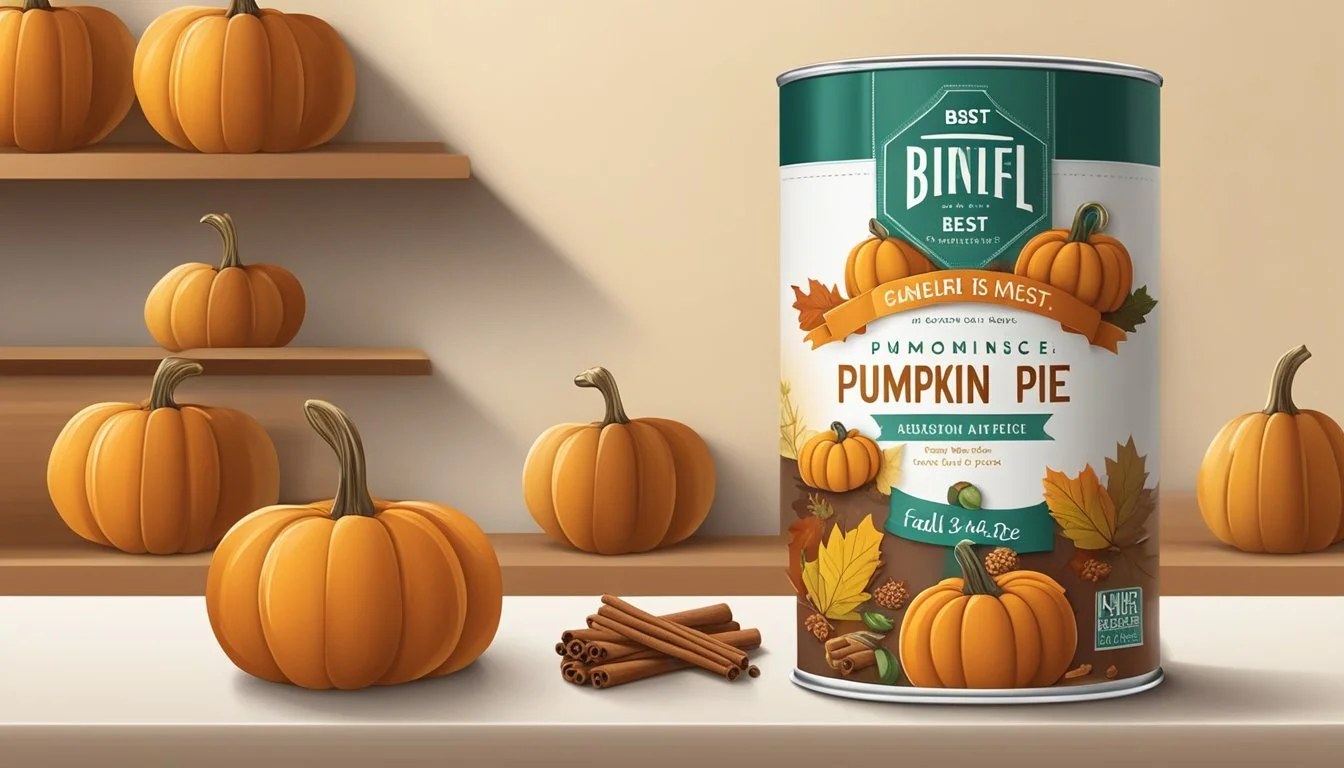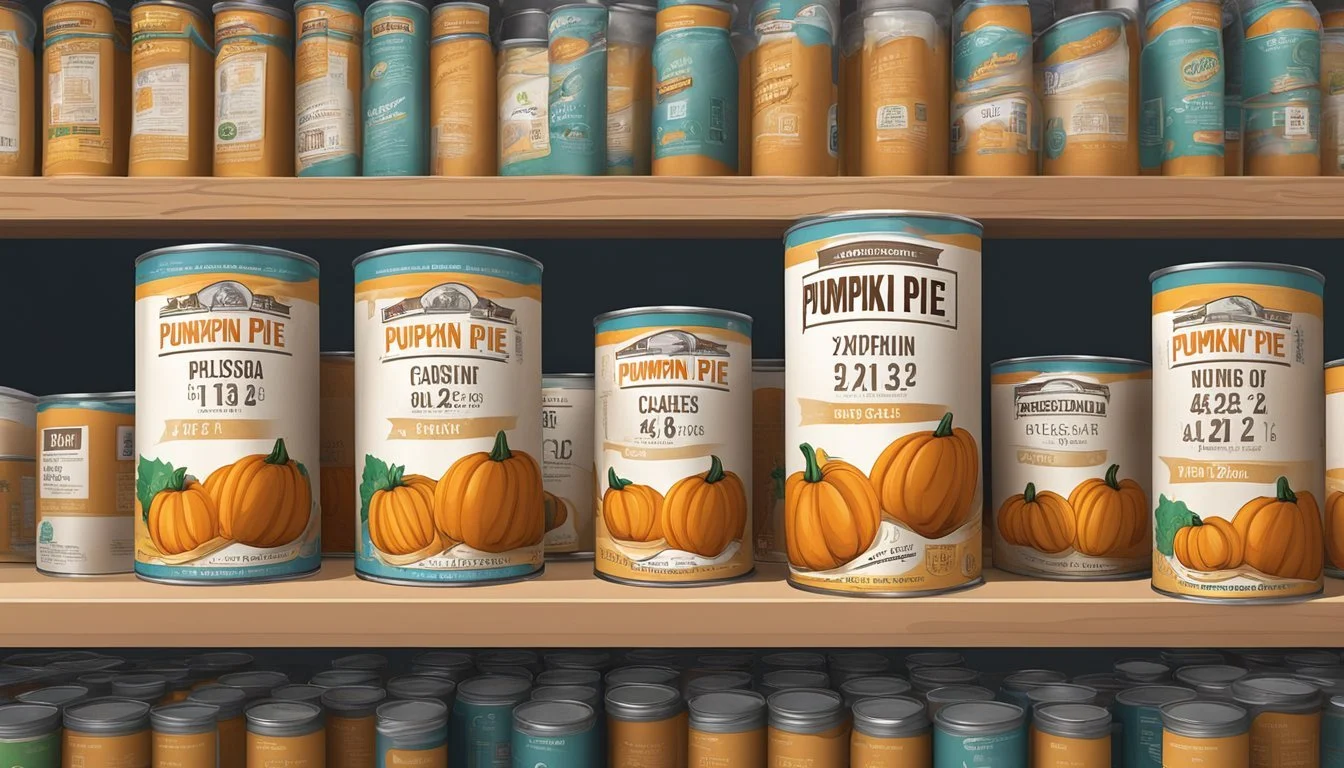Does Canned Pumpkin Pie Mix Go Bad?
Shelf Life and Storage Tips
Canned pumpkin pie mix can indeed go bad, and it's important to be aware of how to recognize when this happens in order to ensure the quality and safety of your baking projects. An unopened can of pumpkin pie mix can last for several years past its expiration date if stored properly in a cool, dry place. However, once opened, it should be transferred to an airtight container and kept in the refrigerator, where it should be used within five to seven days.
Identifying spoilage in pumpkin pie mix is straightforward. It’s best to look for any signs of mold, unusual odors, or changes in texture and color. If the canned pumpkin pie mix develops an off odor, flavor, or appearance, it should be discarded. Leaking, rusting, bulging, or severely dented cans also indicate that the mix may no longer be safe to use.
Storing canned pumpkin and pumpkin puree correctly is key to maximizing their shelf life. Keeping unopened cans in a pantry or cabinet can help preserve their quality. After opening, both pumpkin puree and pumpkin pie mix should be refrigerated in a sealed container to maintain freshness and prevent spoilage.
Understanding Canned Pumpkin Pie Mix
Canned pumpkin pie mix is a convenient product designed specifically for making pumpkin pies. It combines pumpkin puree with spices and sweeteners, making it a ready-to-use ingredient.
Composition and Nutritional Profile
Canned pumpkin pie mix primarily consists of pumpkin puree, which is the base ingredient. It also includes spices such as cinnamon, clove, allspice, and ginger. These spices contribute to the traditional flavor of pumpkin pie. Additionally, the mix is sweetened with sugar and may contain thickeners to ensure the right consistency.
Pumpkin pie mix offers nutritional benefits similar to plain pumpkin puree. It's rich in fiber, beta-carotene, and potassium. However, the added sugar increases the calorie content compared to pure pumpkin. Despite the sugar, it still provides nutrients that support health.
Varieties and Usage in Recipes
Canned pumpkin pie mix is available in various brands, each with its own spice blend and sweetness level. This product is specifically formulated for ease of use in pie-making. It's perfect for those who want to save time and avoid measuring spices.
Besides pies, the mix can be used in other desserts and baked goods. Its sweet and spiced profile makes it suitable for cakes, muffins, and even smoothies. It's important to note that the mix is usually not interchangeable with plain canned pumpkin puree in savory recipes.
Labeling and Expiration Date
Understanding the labeling is crucial when selecting canned pumpkin pie mix. The label typically indicates that it is a "pumpkin pie mix" or "spiced pumpkin mix," differentiating it from plain pumpkin puree. Other ingredients like spices, sugar, and thickeners are also listed.
Canned pumpkin pie mix comes with a best-by date, which suggests the period during which the product retains optimal quality. While it may still be safe to eat beyond this date if stored properly, flavor and texture can degrade. It's advisable to store the mix in a cool, dry place and to refrigerate any leftovers after opening.
Storage Guidelines
Proper storage of canned pumpkin pie mix is essential to maintain its quality and safety. The key points to focus on include ideal storage conditions, shelf life considerations, and freezing methods.
Proper Storage Conditions
Unopened canned pumpkin pie mix should be stored in a cool, dry place such as a pantry or cabinet.
The ideal temperature for storage is at room temperature away from direct sunlight and heat.
Once opened, transfer any unused portion to an airtight container and keep it in the refrigerator.
Ensuring the container is well-sealed helps maintain freshness and prevents contamination.
Shelf Life Factors
The shelf life of unopened canned pumpkin pie mix is typically around 18 months.
Always check the expiration date on the can for the best quality assurance.
Once opened, the mix should be used within five to seven days when stored in the refrigerator.
Texture and flavor may deteriorate over time, making it ideal to use the product closer to its opening date.
Freezing and Thawing Instructions
For longer storage, consider freezing the pumpkin pie mix.
Place the opened mix in a freezer-safe container or heavy-duty freezer bag, removing as much air as possible.
Label the container with the date of freezing.
To thaw, transfer the mix to the refrigerator and leave it for several hours or overnight.
Avoid thawing at room temperature to prevent bacterial growth.
Freezing and proper thawing help extend the life of the mix without significantly compromising quality.
Detecting Spoilage
Identifying spoilage in canned pumpkin pie mix is crucial to ensure safety and quality. Key indicators include visual changes, deviations in texture, as well as alterations in smell and taste.
Visual and Textural Changes
Visual inspection of the can should be the first step. Look for bulging or leaking cans, which are signs of bacterial growth. Rust on the exterior might compromise the can’s integrity, leading to spoilage.
After opening, the mix should be smooth and consistent. An unusual texture, such as lumpiness or a watery appearance, can indicate spoilage. Mold growth, seen as fuzzy patches, is a clear indication that the mix should be discarded. Keeping a keen eye on these changes can help in determining the safety of the product.
Changes in Smell and Taste
An off smell is a significant indicator of spoilage. Fresh canned pumpkin pie mix has a mild, sweet aroma. If the mix emits a sour or rancid odor, it likely has gone bad.
Taste is another sensitive marker. If the mix tastes sour or has an unpleasant flavor, this can signal that spoilage has occurred. Always perform these checks before consuming or using the mix in recipes to avoid health risks. Trust these sensory tests to maintain safety and quality.
Handling and Preparing After Opening
Once canned pumpkin pie mix is opened, proper handling is crucial to maintain its taste and quality. This section covers important precautions and creative uses for any leftover pumpkin puree.
Precautions to Maintain Quality
After opening canned pumpkin pie mix, transfer any unused portion to an airtight container. This helps prevent contamination and retains the mix's moisture and flavor.
Refrigerate promptly. Store the container in the refrigerator, maintaining a temperature below 40°F (4°C). It’s best to consume the mix within five to seven days to ensure freshness and prevent spoilage.
Inspect regularly. Check for signs of spoilage such as mold, off-smells, or a change in color. If any of these indicators are present, discard the pumpkin mix immediately.
Recipe Adaptations and Substitutions
Leftover pumpkin puree offers versatility in various recipes. Pumpkin bread is a popular choice, utilizing the puree to add moisture and flavor.
Smoothies can benefit from the rich, creamy texture of pumpkin puree. Combine with yogurt, spices, and other fruits for a nutritious drink.
For savory options, soups can incorporate the puree for a thick, flavorful base. This is particularly effective in autumnal recipes like curried pumpkin soup.
When substituting pumpkin in recipes, ensure the swap is for items with similar consistency and moisture content. For example, pumpkin puree can replace sweet potatoes or butternut squash in many dishes.
These precautions and substitutions ensure that the pumpkin puree remains safe to eat while providing a variety of delicious ways to enjoy it.
Maximizing Shelf Life and Usage
Canned pumpkin pie mix can last a long time when stored correctly. Learn how to keep it fresh for longer and discover creative ways to use any leftovers.
Tips to Extend Freshness
Store unopened cans in a cool, dry place such as a pantry or cabinet. Proper storage conditions help maintain the quality of the canned pumpkin pie mix for up to 3 to 5 years.
After opening the can, transfer any unused portions to an airtight container. Store this container in the refrigerator, where it can stay fresh for up to 2 weeks.
Check for signs of spoilage like off smells or mold before using any leftover canned pumpkin. Proper storage not only extends the shelf life but also keeps the pumpkin at its peak quality.
Creative Uses for Leftover Canned Pumpkin
Leftover canned pumpkin isn't just for pies. It can transform into a variety of delicious dishes.
Sweet and Savory Dishes: Use it in pumpkin bread or pumpkin soup. Add it to baked goods such as muffins or cookies for an extra flavor boost.
Smoothies: Boost your daily smoothie with a scoop of canned pumpkin. It adds nutrients and a creamy texture.
Soups and Main Courses: Incorporate it into soups and other savory dishes. It pairs well with spices and herbs, enhancing the flavors.
These ideas ensure that none of your canned pumpkin goes to waste and keeps your meals interesting.
Health and Safety Considerations
When dealing with canned pumpkin pie mix, it's crucial to follow food safety best practices to prevent any health issues. Additionally, understanding the nutritional benefits of pumpkin can help consumers make informed choices.
Food Safety Best Practices
Expired canned pumpkin pie mix can pose health risks if not handled properly. The primary concern is the growth of harmful bacteria and mold. These microorganisms can lead to foodborne illnesses, making it essential to check the integrity of the can.
Inspect the Can: Make sure the can is undamaged and free from rust. Any dents or leaks could indicate contamination.
Storage: Store canned pumpkin in a cool, dry place. Once opened, transfer any unused portion to an airtight container and refrigerate.
Expiration Dates: Canned pumpkin can generally be used past its expiration date if stored correctly. However, always check for signs of spoilage such as an off smell or changes in texture and color.
Health Benefits of Pumpkin
Pumpkin is more than just a tasty ingredient; it offers various health benefits. It is rich in beta-carotene, which the body converts into vitamin A, essential for eye health.
Nutritional Profile: Pumpkin provides a good amount of potassium, which is vital for maintaining proper heart function and regulating blood pressure.
Dietary Fiber: High fiber content in pumpkin contributes to digestive health and helps in maintaining a healthy weight.
Antioxidants: The antioxidants in pumpkin, including beta-carotene, help protect the body against free radicals, reducing the risk of chronic diseases.
Incorporating pumpkin into your diet can provide multiple health advantages, making it a beneficial choice for both culinary and nutritional purposes.
Comparing Fresh and Canned Pumpkin
When comparing fresh pumpkin to canned pumpkin, differences in taste, texture, convenience, and versatility become apparent. Both have unique characteristics that can elevate various recipes, and choosing between them depends on specific needs and preferences.
Taste and Texture Analysis
Fresh pumpkin offers a vibrant, natural flavor that many consider superior for certain dishes. It provides a texture that can be customized based on the cooking method, whether baked, roasted, or pureed. Canned pumpkin, often marketed by brands like Libby, typically contains a mix of pumpkin varieties resulting in a slightly less intense flavor but a consistently smooth texture.
Homemade pumpkin puree from fresh pumpkins allows for more control over the final product, perfect for dishes like soups and casseroles. In contrast, canned pumpkin's uniform consistency is ideal for quick preparations like pumpkin pies and autumn-themed desserts.
Convenience and Versatility
Fresh pumpkin requires more preparation time, including cutting, seeding, baking, and pureeing, which can be cumbersome for busy cooks. This process, though rewarding, might deter those looking for a quick-fix solution. Canned pumpkin, on the other hand, is ready-to-use, saving significant time and effort in the kitchen.
The versatility of both fresh and canned pumpkin is noteworthy. Fresh pumpkin can be used in a variety of culinary applications such as soups, stews, and baked goods. Canned pumpkin is particularly favored for its ease in recipes ranging from pumpkin pies to smoothies, providing a convenient option for those who want to add a seasonal touch to their dishes with minimal fuss.






